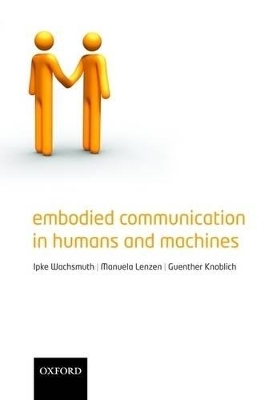
Embodied Communication in Humans and Machines
Oxford University Press (Verlag)
978-0-19-923175-1 (ISBN)
When people communicate face to face they don't just exchange verbal information. Rather, communication encompasses the whole body. Communication partners synchronize their body sway, and mimic or imitate each other's body postures and actions. They produce a multitude of manual and facial gestures that help to illustrate what is being said, show how communication partners feel, or or reveal verbal deception. Moreover, face-to-face communication takes place in shared contexts where partners jointly attend and refer to the same objects, often while working on joint tasks such as carrying a table or repairing a car together.
Traditionally, communication research has neglected these parts of communication using the engineering model of signal transmission as the main theoretical metaphor. This book takes a new look at recent empirical findings in the cognitive and neurosciences, showing that the traditional approach is insufficient, and presenting a new interdisciplinary perspective, the Embodied Communication perspective. The core claim of the Embodied Communication perspective is that human communication involves parallel and highly interactive couplings between communication partners. These couplings range from low-level systems for performing and understanding instrumental actions, like the mirror system, to higher-systems that interpret symbols in a cultural context. The book can also serve as a guide for engineers who construct artificial agents and robots that should be able to interact with humans.
Ipke Wachsmuth is director of the Center for Interdisciplinary Research (ZiF) and Chair of Artificial Intelligence at the University of Bielefeld. He holds a Mathematics Master's degree and a Ph.D. both from the University of Hannover and an Informatics Habilitation degree from the University of Osnabrück. Before coming to Bielefeld, in 1989, he held faculty and project leader positions in the Department of Mathematics/Computer Science and the Linguistics Department at the University of Osnabrück. He was also assistant professor in the Department of Mathematical Sciences at Northern Illinois University in 1981-83 and research fellow at IBM Germany in 1986-88. Ipke Wachsmuth is a former president of the German Cognitive Science Society and has a strong multidisciplinary commitment, reflected in many research papers published in areas related to the understanding and modeling of human behavior as well as the exploitation thereof in intelligent systems. Manuela Lenzen did her Ph D in Philosophy 2002 at the University of Bielefeld and works as a science writer, free lance journalist and translator. Since 2005 she has been Managing Assistant to the Research Group Embodied Communication in Humans and Machines, ZiF, Bielefeld, Germany Günther Knoblich is currently Professor of Social Cognitive Neuroscience at the University of Birmingham. He received his PhD from the University of Hamburg in 1997. From 1997 to 2004 he was a research scientist in the Cognition and Action group of the Max Planck Institute for Psychological Research. From 2004 to 2007 he was Associate Professor of Psychology at Rutgers University. In 2005 he received the American Psychological Association's (APA) Award for Distinguished Early Career Contribution to Psychology. He is Associate Editor of the journal Social Neuroscience. His research interests include body perception and action perception, the sense of agency, and joint action.
1. Introduction to embodied communication ; 2. Some boundary conditions on embodied agents sharing a common world ; 3. Toward a theory of embodied communication: Self-sustaining wild systems as embodied meaning ; 4. Synchrony and swing in conversation: coordination, temporal dynamics and communication ; 5. The visual perception of dynamic body language ; 6. Mirrors for embodied communication ; 7. The role of the mirror system in embodied communication ; 8. Everything is movement: on the nature of embodied communication ; 9. Communication and cooperation in living beings and artificial agents ; 10. Laborious intersubjectivity: attentional struggle and embodied communication in an auto-shop ; 11. The emergence of embodied communication in artificial agents and humans ; 12. Dimensions of embodied communication - towards a typology of embodied communication ; 13. Neurological disorders of embodied communication ; 14. Gestural imagery and cohesion in normal and impaired discourse ; 15. Conversational metacognition ; 16. Imitation in embodied communication - from monkey mirror neurons to artificial humans ; 17. Persuasion and the expressivity of gestures in humans and machines ; 18. Implementing a non-modular theory of language production in an embodied conversational agent ; 19. Towards a neurocognitive model of turntaking in multimodal dialogue
| Erscheint lt. Verlag | 4.9.2008 |
|---|---|
| Zusatzinfo | 59 line figures; 46 black and white photos; 1 colour plate |
| Verlagsort | Oxford |
| Sprache | englisch |
| Maße | 180 x 255 mm |
| Gewicht | 1017 g |
| Themenwelt | Geisteswissenschaften ► Psychologie ► Allgemeine Psychologie |
| Geisteswissenschaften ► Psychologie ► Test in der Psychologie | |
| Geisteswissenschaften ► Psychologie ► Verhaltenstherapie | |
| Informatik ► Theorie / Studium ► Künstliche Intelligenz / Robotik | |
| Naturwissenschaften ► Biologie ► Humanbiologie | |
| Naturwissenschaften ► Biologie ► Zoologie | |
| ISBN-10 | 0-19-923175-3 / 0199231753 |
| ISBN-13 | 978-0-19-923175-1 / 9780199231751 |
| Zustand | Neuware |
| Haben Sie eine Frage zum Produkt? |
aus dem Bereich


